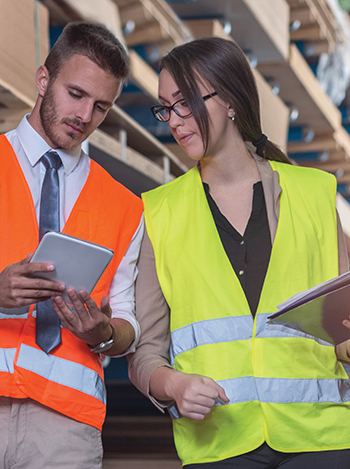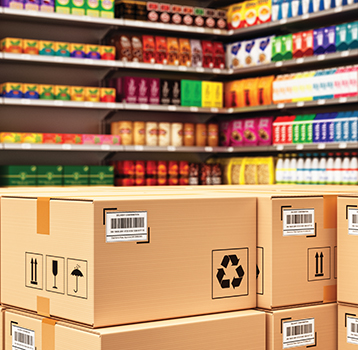Effective Returns Management in an Ecommerce Landscape
By Brian Beetz, Labelmaster Services
Creating Business Value by Taking a Strategic Approach to Managing Reverse Logistics for Lithium Batteries and Other Dangerous Goods
The Era of the Returns Economy
The advent of the internet brought with it instant information at our fingertips, access to endless on-demand entertainment and, most strikingly, an ecommerce juggernaut that turned the consumer retail experience on its ear. More than ever, modern consumers are empowered to go online and buy what they want when they want it – and expect to be able to return it just as easily. In fact, 41% of shoppers buy variations of a product with the intent of returning.1 And 30% of products ordered online are returned, while a full 92% of consumers say they’ll buy something again if those returns are easy. So it’s no surprise that, in an effort to attract and retain customers, many retailers are invested in catering to these return preferences.2
The reality, however, is that this e-returns economy will only grow larger – products bought at brick-and-mortar stores are returned around 9% of the time10, while the return rate for online purchases is nearly 3x higher at 25-30%, and totals $113-$132 billion in the U.S. annually.”3 In the end, this “if I don’t like it, I can just return it” consumer approach to online purchases will end up costing retailers and the logistics chain time, resources and money. In the U.S. alone, return deliveries will cost $550 billion by 2020, 75.2% more than four years prior.4
This onslaught of return deliveries – both consumers returning to stores and stores returning to manufacturers and distributors – has created a challenging reverse logistics environment. Case in point: 52% of distribution center managers don’t have the ability or resources to determine whether returned items should be sent to the vendor, moved into inventory, or discarded.4 This issue is especially vexing for technology manufacturers who, according to UPS, could be losing more than 50% of returned inventory value without a well-developed reverse logistics process.4 And it’s compounded by the fact that many technology returns involve lithium batteries and the devices they power, which makes returns management even more complicated – and regulated.

Reconciling Reverse Logistics and Lithium Batteries
Not only are more products being purchased and returned online – more of them are electronics and technology items that contain hazardous components, including lithium batteries. Considering that almost one in 10 U.S. retail purchases get returned, any retailer that sells electronics must be prepared to handle reverse logistics for lithium batteries and other dangerous goods, and must comply with the same hazmat rules, restrictions and provisions that apply to shipping these items to consumers in the first place.
That’s why the reverse logistics landscape has become a complicated one. According to the United States Postal Service, “The European Union and Japan have instituted product take-back laws requiring manufacturers of certain types of electronics to pay for those goods to be shipped to a place where they can be refurbished or disposed of properly. While there is no national product take-back law in the U.S., 25 states have laws directing the take-back of some electronics.”3 In addition to complying with myriad state laws, companies accepting lithium battery-related product returns from both consumers and distributors must align with additional shipping regulations. This can include 2019’s IFR safety provisions for transport, which further prohibit the transport of lithium-ion cells or batteries on aircraft and impose additional marking and labeling requirements for shipments by road, rail and air.
It can also include the Pipeline and Hazardous Materials Safety Administration (PHMSA) Final Rule HM-253, which defines reverse logistics as “the process of offering for transport or transporting by motor vehicle goods from a retail store for return to their manufacturer, supplier, or distribution facility for the purpose of capturing value (e.g. to receive manufacturer’s credit), recall, replacement, recycling or similar reason.”5 The caveat with HM-253 is that it only applies to retailers – not to consumers making direct returns, and it does not include lithium batteries or electronics containing lithium batteries. And, since it’s still the responsibility of the shipper to comply with dangerous goods transportation regulations, it means the customer must be equipped to adhere to hazmat shipping regulations whether they’re aware of them or not. This is where effective returns management and a formalized process for equipping consumers with the right packaging and labeling becomes paramount. Especially given that returned items are typically used or defective, making reverse logistics of lithium-related products a riskier proposition in the first place.
Effective Returns Management: What It Means and Strategies for Achieving It
In today’s modern ecommerce reality, it’s imperative for retailers to make the returns process as simple and streamlined as possible for both customers and themselves. And when it comes to sending back product purchases that contain lithium batteries, safety is also a key factor. Particularly because returned items have a higher chance of being unstable, thereby increasing the potential shipping threat they pose. This is true for retailers sending items back to manufacturers and distributors, and also for consumers directly returning items back to retailers or manufacturers.
Retailers must take responsibility for thoroughly understanding how to safely handle and package lithium battery-related items – including all applicable compliance regulations and requirements – when reverse logistics come into play, and then they must extend that knowledge and understanding to customers by way of return packaging and drop-off instructions. Especially when returns originate from the customer and they are, essentially, responsible for the safe shipping of the item.
How Effective Returns Management Comes into Play
The efficacy of your returns management process directly impacts customer satisfaction and your ability to maintain regulatory compliance. Ecommerce consumers don't want to figure out safe transporting procedures or become educated on the specifics around return shipments and how they’re subject to the regulations governing hazardous materials transport. Consumers simply want to put a product in a compliant shipping package with the required labeling already at hand, and drop it off to their preferred carrier and get on with their day. A big factor in making this a reality is having the right packaging on hand in the first place.

To expedite returns management of lithium batteries and related devices, retailers and other supply chain entities should consider investing in next-generation shipping boxes, which arrive preassembled and pre-labeled with simple closure instructions. The boxes are comprised of materials engineered to specifically provide a thermal barrier for the transportation and storage of lithium batteries and other dangerous goods. In addition to simplicity and ease of use, these modern packaging options offer improved flame retardance/arrestment, thermal management, pressure management, blast containment, and gas and smoke filtration, making the return transport of lithium-related items safer and easier.
Today’s retailers are in a position to positively impact reverse logistics and take a more deliberate approach. Not only to improve the customer experience, but to leverage effective returns management to achieve additional benefits:
• Differentiation from the competition: Being easy to do business with and providing convenient customer service, especially during the returns process, can act as a strong differentiator for your company and help you stand out to consumers, suppliers and all entities within the supply chain.
• Improved brand equity and reputation: For manufacturers and distributors in particular, it’s not uncommon for customers (often retailers) to maintain scorecards related to how easy certain manufacturers or distributors are to work with and then use that data to decide which companies they prefer to partner with in the future. And for retailers, as well as manufacturers who sell directly to consumers, consumer ratings become a key measure of success and repeat business.
• Ability to mitigate risk: Shipping lithium batteries is always high-risk. Ensuring a comprehensive approach to returns management helps reduce that risk to better prevent people from being injured, lessen the chances of getting fined and improve regulatory compliance around hazmat shipping procedures.
• Product recall preparedness: Avoid compounding recall issues. Reduce the potential for a return-shipping incident while the product is en route back to the manufacturer by making the latest packaging part of your process. After all, the average cost of a recall is $10 million for consumer product companies, excluding brand damages or lost sales6. Don’t put your reputation further at risk because of noncompliant reverse shipping.
Strategies for a More Effective Returns Management Process
Developing a comprehensive returns management process for all goods, especially lithium batteries and other hazardous products, takes a thoughtful, proactive approach. This begins with a clear understanding of how reverse logistics and returns impact your supply chain and the overall health of your company. It then extends to identifying the impact that a mismanaged process could have on customer perception and brand reputation, followed by a determination of more streamlined ways to marry efficiency with safety in order to achieve positive change.
To that end, a strategic, holistic approach to returns management should take the following into account:
• Educate: Make customers aware that rules exist and guide them on shipping requirements for the product being returned. Remember that, until PHMSA clarifies their reverse shipping regulations around customer returns, you have the responsibility of acting as your customers’ de facto dangerous goods consultant.
• Keep it simple for consumers: Deliver all lithium-battery related shipments with all the labels and markings necessary for fully compliant returns. You must be the expert on shipping compliance so customers don’t have to be.
• Prepare customer service teams: Make sure your customer service reps are trained to correctly answer customers' questions about return shipments of lithium battery-related goods. Consumers and retailers may need to send back defective or unwanted products, and won’t be trained in compliant lithium battery shipping, so your customer service reps need to be ready.
• Stay grounded: Be sure all return shipments are made via ground shipping, as there are allowable regulatory exceptions for this transportation mode as compared with air travel. In fact, even the shipment of properly functioning lithium batteries by plane (let alone defective merchandise being returned) is now significantly more complicated since the passing of ICAO restrictions which took effect on April 1, 2016.
• Be open to alternatives: Consider implementing a practice of automatically sending consumers replacement items and foregoing the returns process completely. By eliminating the need for the consumer to responsibly return ship a lithium-battery related product, and by making sure to provide them with information on the proper disposal of the items they originally wanted to return, you can help make the supply chain safer and reduce the transportation risk for hazardous goods.

Moving Forward While Products Keep Going Back
As more retailers vie for a piece of the ecommerce pie and aim to take on Amazon in terms of fast, 1-day shipping, the number of shipments being sent directly to stores for pickup or straight to consumers’ homes will only accelerate. Given that connected technologies, “smart” products and other innovative electronics are hot commodities, it stands to reason that an increasing number of lithium batteries will enter the reverse logistics supply chain.
To meet consumer expectations, maintain a positive reputation, ensure safety of all involved with lithium battery-related devices and improve the customer experience, those responsible for return transport will be particularly in the spotlight when it comes to returns management procedures. Now is the time to formalize and streamline the process, integrating safety protocols and customer and employee education into the newly standardized process. It’s the one way companies can remain competitive while helping to future-proof against the additional compliance regulations and shipping mandates that are sure to come down the line and ultimately impact operations and profitability.
# # #
Sources:
5Federal Register, Vol. 81, No. 62. Thursday, March 31, 2016
 Brian Beetz
Brian BeetzBrian Beetz is manager, regulatory
affairs and corporate responsibility
at Labelmaster. He has over 20
years of experience in the hazard
communication, and environmental,
health and safety sectors, and worked in
the environmental consulting industry
prior to joining Labelmaster. His education includes a degree from Northern Illinois University, as well as extensive training on the regulations pertaining to the safe and secure transportation of dangerous goods domestically and internationally.